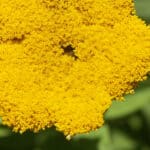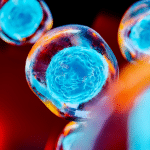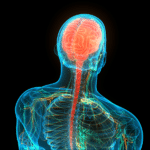あなたの脳は海のようなものだと考えてください——神経伝達物質やその受容体など、さまざまな種類の、魚のような生き物が棲んでいる生態系です。電気という潮の流れが、さまざまな要素をつなぎ、微妙にそのバランスを保っています。炎症は紅藻類の繁殖のようなもので、その周りにあるすべてに害を与え、周囲の環境のホメオスタシスを乱します。
そこに私たちのヒーロー、パルミトイルエタノールアミド(PEA)——の登場です。PEA はエンドカンナビノイド・システムと縁が深い脂質性メッセンジャーであり、おなじみの内因性カンナビノイド、アナンダミド(AEA)とは従兄弟のような関係にあります。「内因性の CBD」と呼ばれることもある PEA には、強力な抗炎症作用と鎮痛作用があります。CBD と同様に、PEA もまた、体内の内因性カンナビノイドの量を増やし、エンドカンナビノイド・システムを強化します。また、やはり CBD と同じく、科学文献においては、PEA は安全性が非常に高いことが常に指摘されています。
海の喩えで言えば PEA は、いわばニンマリ笑ったセミクジラのような「最も畏敬すべき海獣」であり、私たちが常々悩まされている炎症と疼痛との闘いにおける屈強なファイターです。
PEAの謎
PEA の物語は謎に始まり、謎が謎を呼んで、やがてカンナビノイド革命の次なる大きな波につながります。
第2次世界大戦中に始まったこの物語には、政治が重要な役割を果たしています。戦争中は、「公衆衛生」と呼ばれる比較的新しい分野が盛んになりました——軍需物資の生産を支えるために、健康な労働者がいることが必要不可欠だったからです。ニューヨークでは、Coburn と Moore という名の2人の医師が、低所得者層の居住区の子どもたちに乾燥卵を食べさせると、リウマチ熱その他、栄養不足に関連する病気の予防に役立つということを発見しました。同時に、卵黄には抗炎症作用があることもわかりました。
普通、ある植物や食べ物が独特の健康効果を持っていることがわかると、科学者は、その効果をもたらしている分子を特定しようとします。そしてそれは多くの場合タンパク質です。なぜなら、細胞内部での主要な働き手がタンパク質だからです。ところがこの場合、研究者がさまざまな種類の分子を分離していったところ、健康効果をもたらしているのは脂質であることがわかったのです。
タンパク質はたしかに働き者ですが、どちらかと言うと二値性、つまり、タンパク質の働きはオンかオフであることが多いのに対し、脂質はもっとアナログな形で作用を発揮します。人間の細胞は、ほんのわずかな脂質量の変化を感知するのが得意で、その変化に従って反応します。以前は、脂質は単なる細胞の栄養源と考えられていましたが、現在は、身体のホメオスタシス(恒常性)を維持するために繊細に調節された細胞システムであることがわかっています。でも、卵の脂質はいったいどうやってホメオスタシスを維持するのでしょうか?
脂質が作用する仕組み
PEA の研究における最初の大きなブレイクスルーは 1950年代、F. A. Kuehl 博士の研究チームが、卵黄に含まれている抗炎症作用のある成分をパルミトイルエタノールアミドと同定したことでした。やはり抗炎症作用を持つ2つの食品、大豆とピーナッツにもこの分子が含まれていることもわかりました。
ただ、この興味深い脂質が炎症に作用する機序はなかなかわかりませんでした。1960年代になり、アニマルモデルを使った研究論文がいくつか発表され、PEA の抗炎症作用が確認されます。そして重要な展開があったのは、S. Udenfriend 博士の研究チームが、哺乳動物のさまざまな臓器内に PEA がそもそも含まれていること、それもかなり多量であることを発見したことです。そこから、PEA は炎症を鎮めるだけでなく、私たち自身の身体や脳もまた、体内の炎症制御機能として PEA を産生することがわかったのです。
でも、最初の本格的な臨床試験が行われたのは 1970年代になってからで、今では存在しない国、チェコスロバキアでのことでした。SPOFA(United Pharmaceutical Works)というチェコの製薬会社が、Impulsin という PEA製剤を開発し、その臨床試験を行ったのです。SPOFAは、自動車、戦車、産業機器などを製造し、膨大な数の社員を抱える企業 Skoda の協力を得て、工場の従業員を対象とした臨床試験を複数行うと同時に、軍の関係者や一般市民を対象とした試験も行いました。これらの臨床試験には、合計すると 2,000人の成人と 400人の子どもが参加しました。
これらは二重盲検(現代の医学臨床試験で最も信頼性の高い方法)で行われ、そのすべての結果が同じ方向を示していました——つまり、PEA は安全で、気管支の感染の治療に明らかに効果があり、発熱、頭痛、喉の痛みの発生率を低下させたのです。さらにチェコの研究者は、「軍隊と一般市民を対象に数年間にわたって行われた Impulsin の臨床試験では、副作用は認められなかった」と述べています。
こうして、PEA に医療効果があることが大規模試験で証明されました。ところがこの後、内因性カンナビノイド研究者の間で「沈黙のギャップ」と呼ばれる時代が続きます。
SPOFA による研究は、1980年代前半、いわゆる鉄のカーテンの後ろで姿を消していきました。PEA に対する関心が弱まったのは、科学者が PEA の作用の仕組みを説明できなかったためでもありました。誰もその実際の作用機序を解明することができなかったのです。結局 PEA には、「不特定免疫強化剤」というレッテルが貼られ、科学界は関心を失ったように見えました。
蘇るPEAへの関心
この状況を変えたのは、1993年、この記事のヒロインと言える Rita Levi-Montalcini 博士の登場でした。
このあたりから、政治の影響が色濃くなっていきます。Levi-Montalcini 博士は若い頃、ムッソリーニ政権下で、ユダヤ人であったために研究室を失いました。やむなくフィレンツェに避難した博士はそこで、一軒の家の地下に作業場をつくり、あらゆる科学分野の中でも最も難しい分野の一つである、生物の初期開発段階に関する研究を続けました。その地下室で行われた研究によって博士は神経成長因子(NGF)を発見します。これは、神経化学における今世紀最大の発見の一つであり、これによって博士は 1986年にノーベル賞を受賞しています。
7年後、ローマの Institute of Neurobiology と提携していた Levi-Montalcini 博士の研究チームが名高い論文を発表し、その中で、PEA はマスト(肥満)細胞——ヒスタミンを放出する重要な白血球——を制御することによって作用するという仮説を打ち出しました。アレルギーと結びつけて考えられることが最も多いヒスタミンは、実はホルモンでもあり、また炎症反応に関与する神経伝達物質でもあります。マスト細胞は、傷を治癒したり、血管を新生したり、病原菌から身体を保護したり、免疫反応をまとめたりといった役割があります。
彼らは、PEA とマスト細胞の関係を「ALIA 仮説」と名付けました。
『Journal of Pain and Relief』に掲載された、Levi-Montalcini 博士らの研究に対するレビュー論文は、「オータコイド(局所ホルモン)は、局所的に産生され、局所的にその作用を発揮する調節分子の古風な呼び方である。PEA は、炎症または神経原性疼痛が起きた場合に局所的に生成され、PEA の濃度の上昇は、疼痛や炎症に対処する身体の仕組みに基づいている。これは『オンデマンド合成』と呼ばれる」と要約しています。
「ALIAmide(Autacoid Local Injury Antagonism の略)とは、損傷や炎症に反応して合成されるオータコイドであり、局所的に作用する。したがって、PEA は典型的な ALIAmide の一例である。マスト細胞は、Levi-Montalcini 博士による画期的な論文が発表されて間もなく、実際に PEA の抗炎症作用の重要な作用標的であることが示されており、1993年から 2013年の間に、PEA がマスト細胞に与える影響に関する 30本以上の論文が発表されている」
重要な論文が発表されると往々にして起きることですが、PEA の作用機序という謎が一部解決されたことで、そうしたヒントを引き継いで PEA がマスト細胞を調節する正確な機序を解明しようとする多くの科学者が現れました。
PEAと疼痛
PEA の理解に重要な進展が見られたのは、たまたま 1998年に、ナポリの研究チームがアナンダミドを研究していたときのことでした。神経伝達物質である内因性カンナビノイド、アナンダミドは、その構造が PEA に似ています。(どちらの脂質化合物も「N-アシルエタノールアミン」。)具体的にこのチームが研究していたのは、アナンダミドが持つ「脊髄を介した痛みの伝達を阻害することによって痛みが脳に到達する以前に鎮痛効果を発揮する力」についてでした。
この研究チームは、実験におけるプラセボの役割を果たす対照物質が必要だと考えました。Daniele Piomelli 博士によれば、アナンダミドと同じ作用は持たない、別の内因性カンナビノイド様分子を探しており、PEA を選んだのです。その主な理由は、鎮痛作用を引き起こしていると考えられていた CB1 および CB2 受容体に、PEA が結合しないということがわかっていたからでした。ところが、『Nature』誌に掲載された論文にあるように、PEA にも強力な鎮痛作用があることがわかり、彼らは大変驚きました。
そして彼らはこの結果に興味を持ちました。PEA は CB1 と CB2 受容体に結合しないのに、なぜ鎮痛作用を発揮するのでしょうか?
研究チームは、オレイン酸アミド(OEA)と呼ばれる、PEA に似た脂質化合物が、PPARα 受容体を介して働くのではないかと考えました。PPARα が特別なのは、それが核内受容体であるという点です。細胞の表面ではなく、細胞核(DNA を含む、細胞の司令塔)の表面にあるのです。(喩えて言えば、細胞核は市役所、PPARα 受容体は命令を送る役人です。)PPARα 受容体が活性化すると、遺伝子転写に変化を起こし、その結果産生される新しいタンパク質も変化します。新しいタンパク質にはそれぞれ異なった下流効果があります。細胞が都市だとしたら、遺伝子転写を変化させるというのは、問題を解決するために、それぞれに異なったスキルを持つたくさんの専門家を雇うようなものです。
Piomelli博士は、Jesse LoVerme という学生に、PEA の作用機序を研究するという課題を与えました。その結果、2005年には PPARα 受容体が PEA の抗炎症作用を媒介していること、2007年には、PEA の鎮痛作用もまた同じ機序で起きていることがわかりました。これは非常に重大なブレイクスルーでした。
PEAとアントラージュ効果
作用機序の解明とポジティブな臨床効果を受けて、PEA 研究は一気に前進しました。2008年にはイギリスの研究チームが、動脈を弛緩させるアナンダミドの働きは PEA が存在すると強くなると報告しました——これは「アントラージュ効果」と呼ばれる現象です。『British Journal of Pharmacology』に掲載された論文には、この現象は、中核体温、炎症性疼痛、たとえばカプサイシンなど辛い食べ物を食べたときの焼けるような感覚といった基本的な内臓感覚などを司る、TRP チャネルという大きなイオンチャネルファミリーの一部であるバニロイド受容体の働きを介して起こると書かれています。
アナンダミドも CBD も、TRPV1 バニロイド受容体に結合します。エンドカンナビノイド・システム(内因性カンナビノイド系)と内因性バニロイド系は非常に密接に絡まり合っているので、アナンダミドがバニロイド化合物の一つと説明されることも多々あります。
2008年に発表された PEA と神経性疼痛に関する論文には、TRPV1 だけでなく、CB1 受容体と、別の核内受容体 PPARγ も関与していると書かれています。それに続く神経性疼痛の研究では、PEA の作用は、アミノ酸の放出を増やし、また脳の主要な興奮性伝達物質であるグルタミン酸の働きを回復させることによるものであることがわかりました。(グルタミン酸については以前 Project CBD の記事で取り上げています。)
さまざまな疾患のマウスモデルを使った実験では、PEA は炎症を軽減させ、細胞死を減少させ、組織障害を防ぐことがわかりました。それには往々にして、複数の生化学的経路が関わっていました。また PEA は、怪我をしてどんな治療も奏効しなかった四頭の馬が障害馬術競技に復帰するのを助けました。
今では科学者たちは、PEA は、微量である場合もあるものの、あらゆる哺乳動物の細胞に存在すると考えています。
臨床研究
人を対象とした実験でもめざましい結果が出ています。片頭痛、下背部痛、口腔灼熱症候群、脊髄損傷、帯状疱疹による神経性疼痛の患者に PEA を投与すると、疼痛が軽減され、標準治療の補完療法として有効でした。PEA はまた、間質性膀胱炎・膀胱痛症候群、過敏性大腸炎、緑内障、膝の変形性関節症の患者や、運動後の疲労回復にも効果がありました。(PEA が奏効した疾患のより包括的なリストは、この記事の末尾にある「PEA と疾患」を参照のこと。)
抗がん剤治療を受けている 20人が PEA を使ったところ、痛みが軽減し、「神経機能が大幅に回復」しました。ALS の患者では、PEA が、おそらくはマスト細胞とミクログリア(脳を護る免疫細胞)を介して臨床像を改善させました。多発性硬化症の場合は、PEA と標準治療の組み合わせが疼痛を改善し、炎症を軽減させ、生活の質を向上させました。治療抵抗性の慢性疼痛患者 600人を対象とした観察研究では、PEA が効果的かつ安全であるという結果でした。また7人の慢性特発性軸索性多発ニューロパチー(原因不明の強い神経性疼痛)患者では、PEA が副作用なしに大幅に痛みを軽減させた他、片頭痛のある子ども 70人にも効果を発揮しました。
子宮内膜症と慢性骨盤痛を患っている女性 24人に PEA とポリダチン(PEA と一緒に投与されることが多いフラボノイド)の組み合わせを投与したところ、生理痛、性交時の痛みが軽減し、全体的な生活の質が向上しました。その後、さらに 30人の患者で同様の結果が報告されています。また 30人の糖尿病患者では、PEA は神経性疼痛の軽減に効果があり、血液と尿の検査結果に何らネガティブな変化は認められませんでした。自閉症患者 2人においては、PEA によって「認識能力、行動、社会性が急激に改善」しました。うつ病患者 58人については、シタロプラムに加えて 600 mg の PEA を一日2回摂取したところ、症状が大幅かつ速やかに改善しました。さらに、PEA は局所薬としても有効で、湿疹のある皮膚に塗布すると痒みが軽減してよく眠れるようになり、患者の多くは副腎皮質ステロイドの使用を止めることができました。
PEA に関しては、これらの研究結果のすべてに共通して繰り返し登場する評価があります。「副作用がまったく見られないことから、その安全性が確認された」というものです。
健康補助食品としての PEA
数十年にわたって一連の科学的な謎を解明し、その結果得られた貴重な発見の数々によって、PEA は単なる卵黄の成分から、次なる素晴らしい健康補助食品に変貌しました。
私たちの脳という海の中で姿を見せる PEA というクジラは、行く先々で、炎症と痛みの軽減を指揮し、その魔法の力を発揮します。ClinicalTrials.gov には、現在参加者を募集中、進行中、あるいはすでに完了した PEA の臨床試験が 144件登録されています。FSD Pharma は、炎症性疾患またはマスト細胞の活性化のための PEA 製剤の第2相試験を行っています。
PEA はすでに、世界中で広く使用されています。イタリアとスペインでは健康補助食品として承認されていますし、ヨーロッパの製薬会社 Lesvi は、PEA といくつかの植物を組み合わせた、脳のための健康補助食品を販売しています。オランダには、PeaPure という製剤を作っている会社がありますし、Gencor Pacific 社の Levagen+ という製品は、関節の健康、気分、睡眠、免疫系の健康、運動後の疲労回復に効果があり、生活の質を高めるともてはやされています。
幸いアメリカでも、食物由来の PEA を合法的な健康補助食品として入手するのは比較的容易です。いくつもの信頼の置けるメーカーが PEA 製品を販売していますし、オンラインでの購入も可能です。使用者の体験談は、CBD と PEA が互いの抗炎症作用を強めあうことを示唆しており、この2つの組み合わせは強力な治療の選択肢となるかもしれません。
Lex Pelger は、向精神物質に関する記事やエンドカンナビノイド・システムに関するコミックの著者。初めての著作『SUNset』がアマゾンで販売中。カンナビノイドの科学に関する週刊ニュースレター Cannabinoids & the People を発行する他、重篤な疾患に対して CBD、PEA、THC、CBDA を使う方法をマンツーマンで指導している。
当サイトの著作権は Project CBD にあります。許可なく転載を禁じます。
PEAと疾患
2013: A Kuhnian take on evolution of PEA knowledge
Evolution in pharmacologic thinking around the natural analgesic palmitoylethanolamide: from nonspecific resistance to PPAR-α agonist and effective nutraceutical
PEA研究に関する優れたレビュー論文
- 2022: A review on the potential of using PEA for antiseizure effects
Is It Time to Test the Antiseizure Potential of Palmitoylethanolamide in Human Studies? A Systematic Review of Preclinical Evidence - 2021: From Gencor (producers of the PEA product Levagen+, a paper reviewing the wonders of PEA
Palmitoylethanolamide: A Potential Alternative to Cannabidiol - 2021: This review of female pelvic medicine and reconstructive surgery suggests PEA as a treatment
Cannabinoid Therapy in Female Pelvic Medicine and Reconstructive Surgery: Current Evidence and Future Directions - 2021: This review looks at PEA for autism and suggests that it may help via several different mechanisms
Palmitoylethanolamide and Its Biobehavioral Correlates in Autism Spectrum Disorder: A Systematic Review of Human and Animal Evidence - 2021: This review looks at the power of PEA to protect the astrocytes (essential support cells of the brain) and fight Alzheimer’s disease
Alternative Targets to Fight Alzheimer’s Disease: Focus on Astrocytes - 2021: This review suggests using PEA for treating COVID patients
Ultramicronized Palmitoylethanolamide (um-PEA): A New Possible Adjuvant Treatment in COVID-19 patients - 2021: This review looks at how PEA and oleoylethanolamide binds to GPR119 and GPR55 (receptors that may one day be known as CB3 and CB4)
GPR119 and GPR55 as Receptors for Fatty Acid Ethanolamides, Oleoylethanolamide and Palmitoylethanolamide - 2021: A special issue of the International Journal of Molecular Sciences is dedicated to PEA
- 2021: This mini-review examines why it makes sense to use PEA to treat COVID (includes one positive case study)
Micronized / ultramicronized palmitoylethanolamide (PEA) as natural neuroprotector against COVID-19 inflammation - 2020: A review of how PEA moves through the body
The Basal Pharmacology of Palmitoylethanolamide - 2020: A review of PEA for pets
Palmitoylethanolamide and Related ALIAmides: Prohomeostatic Lipid Compounds for Animal Health and Wellbeing - 2020: On using PEA for pain (nice charts)
ALIAmides Update: Palmitoylethanolamide and Its Formulations on Management of Peripheral Neuropathic Pain - 2020: PEA + luteolin for neuroinflammation
An Update of Palmitoylethanolamide and Luteolin Effects in Preclinical and Clinical Studies of Neuroinflammatory Events - 2019: A good review of PEA’s mechanisms of action
Clinical Applications of Palmitoylethanolamide in Pain Management: Protocol for a Scoping Review - 2019: A review on PEA for end of life care
The Potential Benefits of Palmitoylethanolamide in Palliation: A Qualitative Systematic Review - 2019: A review on PEA for Alzheimer’s disease with a focus on neuroinflammation
Palmitoylethanolamide (PEA) as a Potential Therapeutic Agent in Alzheimer’s Disease - 2019: On combining PEA with other antioxidant molecules found in your diet (nice diagrams)
Therapeutic Efficacy of Palmitoylethanolamide and Its New Formulations in Synergy With Different Antioxidant Molecules Present in Diets - 2019: A review of PEA for asthma
Molecular Targets of Fatty Acid Ethanolamides in Asthma - 2018: A review of PEA for depression
Role of Palmitoylethanolamide (PEA) in Depression: Translational Evidence: Special Section on “Translational and Neuroscience Studies in Affective Disorders” - 2017: DiMarzo’s great review with history, pharmacology, and charts of where it’s found (breast milk!)
The pharmacology of palmitoylethanolamide and first data on the therapeutic efficacy of some of its new formulations - 2017: A review of PEA and polydatin for endometriosis covers 4 studies
Micronized Palmitoylethanolamide/Trans-Polydatin Treatment of Endometriosis-Related Pain: A Meta-Analysis - 2016: A review of pain covers 6 studies
Palmitoylethanolamide for the Treatment of Pain: Pharmacokinetics, Safety and Efficacy - 2016: This review of 12 studies of patients with pain, PEA decreased pain with no serious adverse events
Palmitoylethanolamide, a Special Food for Medical Purposes, in the Treatment of Chronic Pain: A Pooled Data Meta-analysis - 2015: A review of PEA for nerve compression problems like carpal tunnel and sciatic pain
Palmitoylethanolamide, a Neutraceutical, in Nerve Compression Syndromes: Efficacy and Safety in Sciatic Pain and Carpal Tunnel Syndrome - 2015: PEA as a homeostasis mechanism for neuroinflammation in models of stroke, spinal cord injury, traumatic brain injury, and Parkinson disease
N-Palmitoylethanolamine and Neuroinflammation: a Novel Therapeutic Strategy of Resolution - 2015: In humans, this review of studies finds PEA safe and effective for glaucoma and other retinopathies (nice chart of mechanisms of action)
Palmitoylethanolamide, a Natural Retinoprotectant: Its Putative Relevance for the Treatment of Glaucoma and Diabetic Retinopathy - 2014: A review of PEA for inflammation
Harnessing the Anti-Inflammatory Potential of Palmitoylethanolamide - 2013: A great review of the history of PEA and the clinical trials for the common cold
Palmitoylethanolamide: A Natural Body-Own Anti-Inflammatory Agent, Effective and Safe Against Influenza and Common Cold - 2013: A review of PEA for inflammation from trauma
Palmitoylethanolamide Is a New Possible Pharmacological Treatment for the Inflammation Associated With Trauma - 2013: A review of PEA for cannabis dependence
Palmitoylethanolamide: From Endogenous Cannabimimetic Substance to Innovative Medicine for the Treatment of Cannabis Dependence - 2013: A review of PEA and the mast cells
New Insights in Mast Cell Modulation by Palmitoylethanolamide: “In view of their strategic localization at sites directly interfacing with the external environment, mast cells act as surveillance antennae against different types of injury and can undergo activation, thereby regulating both innate and adaptive immune reactions through the release of several preformed and newly synthesized mediators. Mast cells are now viewed as key players in orchestrating several disorders including both acute and chronic inflammatory processes, and have a role in angiogenesis and hyperalgesia.” - 2012: A review of PEA’s effect on mast cells, glia cells (brain support cells), and neuroinflammation
Mast Cell-Glia Axis in Neuroinflammation and Therapeutic Potential of the Anandamide Congener Palmitoylethanolamide - 2012: Dr. Piomelli’s comments on lipids and PEA
A thickening network of lipids - 2007: Dr. DiMarzo on use for companion animals
Palmitoylethanolamide, Endocannabinoids and Related Cannabimimetic Compounds in Protection Against Tissue Inflammation and Pain: Potential Use in Companion Animals - 2005: Dr. Piomelli on history of discovery
The Search for the Palmitoylethanolamide Receptor
PEA研究年表:
[micronized and ultra-micronized PEA means that the PEA has been put into a small particle size for better absorption]
- 2022: Researchers look to create new molecules that help increase natural PEA levels
Discovery and SAR Evolution of Pyrazole Azabicyclo[3.2.1]octane Sulfonamides as a Novel Class of Non-Covalent N-Acylethanolamine-Hydrolyzing Acid Amidase (NAAA) Inhibitors for Oral Administration - 2022: A major carotenoid from brown seaweed called fucoxanthinol appears to help with inflammation via its modulation of the PEA pathway
Anti-Inflammatory Effects of Fucoxanthinol in LPS-Induced RAW264.7 Cells through the NAAA–PEA Pathway - 2022: This survey shows that most women who used cannabis or the cannabinoids THC, CBD, or PEA for gynecologic conditions reported that it improved pain
Medical Cannabis for Gynecologic Pain Conditions: A Systematic Review - 2022: In a mouse model of obesity, PEA restored the plasticity of their white and brown fat cells, leptin sensitivity, tissue hormone sensitivity and rewired the energy storing white into energy-consuming brown fat cells
Palmitoylethanolamide Promotes White-to-Beige Conversion and Metabolic Reprogramming of Adipocytes: Contribution of PPAR-α - 2022: In a study of 90 patients with COVID-19, PEA reduced inflammatory states, oxidative states and alterations to blood biomarkers
Effects of Ultramicronized Palmitoylethanolamide (um-PEA) in COVID-19 Early Stages: A Case-Control Study - 2022: In obese mice, PEA lessened neuroinflammation as well as anxious behavior
Palmitoylethanolamide dampens neuroinflammation and anxiety-like behavior in obese mice - 2021: In humans with induced migraines, the PEA levels in their spinal cords didn’t raise for those who regularly experienced episodic migraines
Spinal nociceptive sensitization and plasma palmitoylethanolamide levels during experimentally-induced migraine attacks - 2021: In an animal model of stroke, they already knew that PEA protects the blood-brain barrier and the brain itself. This study found that the effects weren’t only mediated by changes in genetic transcription (the PPARα receptor) but also by the regulation of the cell’s microfilaments
PEA prevented early BBB disruption after cerebral ischaemic/reperfusion (I/R) injury through regulation of ROCK/MLC signaling - 2021: In humans, PEA as well as the flavonoid luteolin helped to recover the sense of smell after a COVID infection
Randomized clinical trial “olfactory dysfunction after COVID-19: olfactory rehabilitation therapy vs. intervention treatment with Palmitoylethanolamide and Luteolin”: preliminary results - 2021: In lung cells exposed to the spike protein of SARS-CoV-2, ultramicronized PEA reduced all inflammatory markers
Ultramicronized Palmitoylethanolamide Inhibits NLRP3 Inflammasome Expression and Pro-Inflammatory Response Activated by SARS-CoV-2 Spike Protein in Cultured Murine Alveolar Macrophages - 2021: In Greek Navy SEALS undergoing strenuous exercise, their levels of anandamide, PEA and oleamide all increased, suggesting an adaptive ability of the ECS in helping with stress and heart-rate
Endocannabinoids and heart rate variability alterations after exposure to prolonged intensive physical exercise of the Hellenic Navy SEALs - 2021: A case study of PEA for the neuropathic pain of shingles
Palmitoylethanolamide (PEA) in the treatment of neuropathic pain: a case study - 2021: In rats with spinal cord injuries, PEA alleviated the injury, inhibited inflammation, mitigated oxidative stress, reduced cell death and promoted motor function recovery
PPARα agonist relieves spinal cord injury in rats by activating Nrf2/HO-1 via the Raf-1/MEK/ERK pathway - 2021: In humans, CBD and PEA found safe for the skin
Tolerability Profile of Topical Cannabidiol and Palmitoylethanolamide: A Compilation of Single-Center Randomized Evaluator-Blinded Clinical and In Vitro Studies in Normal Skin - 2021: In rabbits having eye surgery, PEA reduced postoperative inflammation and scarring via the nuclear PPARα receptors
Palmitoylethanolamide (PEA) reduces postoperative adhesions after experimental strabismus surgery in rabbits by suppressing canonical and non-canonical TGFβ signaling through PPARα - 2021: In rats on an obesity diet, PEA as well as oleamide (OEA – another endocannabinoid) functioned as anti-obesity nutritional interventions
Palmitoleoylethanolamide Is an Efficient Anti-Obesity Endogenous Compound: Comparison with Oleylethanolamide in Diet-Induced Obesity - 2021: In mice with inflamed colons, a combination of polydatin (a precursor of resveratrol) and ultra-micronized PEA decreased inflammation via several pathways
PEA/Polydatin: Anti-Inflammatory and Antioxidant Approach to Counteract DNBS-Induced Colitis - 2021: In mice with their left carotid artery tied off, a combination of PEA and rutin (a helpful plant pigment) reduced inflammation, oxidative stress and vascular damage
Micro Composite Palmitoylethanolamide/Rutin Reduces Vascular Injury through Modulation of the Nrf2/HO-1 and NF-kB Pathways - 2021: In a human lung tissue model of COVID-19 infection, a combination of PEA and α-lipoic acid (ALA) reduced oxidative stress and lowered the cytokine storm
A Combination of α-Lipoic Acid (ALA) and Palmitoylethanolamide (PEA) Blocks Endotoxin-Induced Oxidative Stress and Cytokine Storm: A Possible Intervention for COVID-19 - 2021: In a mouse model of traumatic brain injury (and a small clinical study), a combination of PEA and the flavonoid luteolin caused increased neurogenesis as well as improvements in memory recall
Co-Ultra PEALut Enhances Endogenous Repair Response Following Moderate Traumatic Brain Injury - 2021: In human cells, PEA and polydatin lowered vascular inflammation
Palmitoylethanolamide associated to polydatin reduces inflammation in human endothelial vascular cells exposed to doxorubicin and trastuzumab through PPAR-a and NLRP3-related pathways - 2021: In humans with Tourette’s, initial promise was seen with a combination of 10 mg of THC + 800 mg of PEA
A Phase-2 Pilot Study of a Therapeutic Combination of Δ 9-Tetrahydracannabinol and Palmitoylethanolamide for Adults With Tourette’s Syndrome
They found that “improvement in tic symptoms was statistically significant within 1 week of starting treatment compared with baseline” and that “treatment led to an average improvement in tic symptoms of more than 20%.” - 2021: In the brain of a model organism, the injection of PEA or OEA mediated the brain levels of serotonin and acetylcholine
In vivo brain levels of acetylcholine and 5-hydroxytryptamine after oleoylethanolamide or palmitoylethanolamide administrations are mediated by PPARα engagement - 2021: In rats with benign prostatic hyperplasia (the most common benign tumor in males), a combination of PEA and baicalein (an active ingredient in Baikal skullcap) lowered inflammation, reduced oxidative stress and helped to modulate apoptosis (programmed cellular suicide)
Palmitoylethanolamide/Baicalein Regulates the Androgen Receptor Signaling and NF-κB/Nrf2 Pathways in Benign Prostatic Hyperplasia - 2021: In humans with nerve pain from rheumatic diseases, PEA combined well with acetyl-l-carnitine (ALC) to lower inflammation and to increase clinical scores
Efficacy of a fixed combination of Palmitoylethanolamide and acetyl-l-carnitine (PEA + ALC FC) in the treatment of Neuropathies secondary to Rheumatic Diseases - 2021: In humans, this cohort analysis found that the diversity of your gut microbiome was related to your happiness and motivation via the endocannabinoid system, especially via PEA – which they call the endogenous version of CBD
Endocannabinoid system mediates the association between gut-microbial diversity and anhedonia/amotivation in a general population cohort - 2021: In microglial cells (the immune cells of the brain), PEA caused decreased inflammation and increased neuroprotection
Palmitoylethanolamide Modulation of Microglia Activation: Characterization of Mechanisms of Action and Implication for Its Neuroprotective Effects - 2021: A clinical trial where PEA from Levagen+ improves many measures of sleep
Palmitoylethanolamide for Sleep Disturbance. A Double-blind, Randomised, Placebo-controlled Interventional Study - 2021: Engineering bacteria to live in the guts and produce PEA on demand
Engineered Lactobacillus paracasei Producing Palmitoylethanolamide (PEA) Prevents Colitis in Mice - 2021: In mice with varicocele (a disorder of the veins taking blood away from the testicles, a major cause of human infertility), PEA helped via the PPAR-α receptors
The Nutraceutical N-Palmitoylethanolamide (PEA) Reveals Widespread Molecular Effects Unmasking New Therapeutic Targets in Murine Varicocele - 2021: In mice with dermatitis, a topical containing CBD and PEA lessened inflammation
Anti-inflammatory Effect of Cannabidiol and Palmitoylethanolamide Containing Topical Formulation on Skin in a 12-O-Tetradecanoylphorbol-13-Acetate-Induced Dermatitis Model in Mice - 2021: In a rat model of inflammatory pain, PEA combined well with acetyl-l-carnitine (LAC)
Effect of Ultra-Micronized-Palmitoylethanolamide and Acetyl-l-Carnitine on Experimental Model of Inflammatory Pain - 2021: In pregnant rats, even huge doses of PEA caused no measurable harms
Palmitoylethanolamide: Prenatal Developmental Toxicity Study in Rats - 2021: In human with joint pain, PEA reduced pain and improved mood
The Effect of a Dispersible Palmitoylethanolamide (Levagen+) Compared to a Placebo for Reducing Joint Pain in an Adult Population – A Randomised, Double-Blind Study - 2021: In rabbits having eye surgery, PEA reduced postoperative inflammation and scarring via the nuclear PPARα receptors
Palmitoylethanolamide (PEA) reduces postoperative adhesions after experimental strabismus surgery in rabbits by suppressing canonical and non-canonical TGFβ signaling through PPARα - 2020: In a mouse model of Gulf War illness, exposure alters the response to PEA
Pyridostigmine bromide exposure creates chronic, underlying neuroimmune disruption in the gastrointestinal tract and brain that alters responses to palmitoylethanolamide in a mouse model of Gulf War Illness - 2020: On using PEA for neurological disorders
Food supplements based on palmitoylethanolamide plus hydroxytyrosol from olive tree or Bacopa monnieri extracts for neurological diseases - 2020: This hypothetical paper suggests that the ability of PEA to calm mast cells in the lungs may be a potential treatment for COVID
Sodium chromo-glycate and palmitoylethanolamide: A possible strategy to treat mast cell-induced lung inflammation in COVID-19 - 2020: In mice with mood disorders induced by high-fat diets, PEA limits mood disorders and cognitive dysfunction
Palmitoylethanolamide limits mood disorders and cognitive dysfunction induced by high fat diet in obese mice - 2020: In 4 jumping horses with non-responsive lameness, ultramicronized PEA for four months allowed them to return to competition
Oral Supplementation with Ultramicronized Palmitoylethanolamide for Joint Disease and Lameness Management in Four Jumping Horses: A Case Report - 2020: In cells, micronized PEA (FM-LipoMatrix®) combined with lipoic acid and vitamin D3 absorbed better and reduced neuroinflammation
A New Palmitoylethanolamide Form Combined with Antioxidant Molecules to Improve Its Effectivess on Neuronal Aging - 2020: In a cellular model of Alzheimer’s, PEA protected the neurons and increased their survival
Astrocytic palmitoylethanolamide pre-exposure exerts neuroprotective effects in astrocyte-neuron co-cultures from a triple transgenic mouse model of Alzheimer’s disease - 2020: In humans with glaucoma, PEA found helpful
Effect of palmitoylethanolamide on inner retinal function in glaucoma: a randomized, single blind, crossover, clinical trial by pattern-electroretinogram - 2020: For patients with COVID-19, FSD Pharma received FDA approval to submit an Investigational New Drug Application for the use of PEA to increase endogenous levels of endocannabinoid
- 2020: In rats, PEA helpful for eye disorders via the PPARα nuclear receptors
PPARα-Dependent Effects of Palmitoylethanolamide Against Retinal Neovascularization and Fibrosis - 2020: In rats, a look at how PEA causes vasodepression (the lowering of blood pressure) via the heart’s CB1, TRPV1 and probably GPR55 receptors, but not by CB2
Potential Mechanisms Involved in Palmitoylethanolamide-Induced Vasodepressor Effects in Rats - 2020: In a double-blind human study, CBD and PEA both helped reduce permeability in the colon and appear helpful for IBS
Palmitoylethanolamide and Cannabidiol Prevent Inflammation-induced Hyperpermeability of the Human Gut In Vitro and In Vivo-A Randomized, Placebo-controlled, Double-blind Controlled Trial - 2020: In patients with lower back pain, the combination of therapy and ultramicronized PEA lowered pain past clinically relevant levels as well as increasing physical and mental quality of life
Combination of Rehabilitative Therapy With Ultramicronized Palmitoylethanolamide for Chronic Low Back Pain: An Observational Study - 2020: In 70 pediatric patients with migraines, ultramicronized PEA decreased the number and severity of attacks with only one patient experiencing mild side effects (nausea and floating)
Tolerability of Palmitoylethanolamide in a Pediatric Population Suffering From Migraine: A Pilot Study - 2020: In a human study with 28 participants, Levagen+ helpful for exercise recovery by reducing myoglobin and lactate concentration
The Effect of Orally Dosed Levagen+™ (Palmitoylethanolamide) on Exercise Recovery in Healthy Males-A Double-Blind, Randomized, Placebo-Controlled Study - 2020: In mice with dry eye induced by sleep loss, they had lower levels of PEA in the lacrimal gland and its synthetic enzyme (N-acylated phosphatidylethanolamine-phospholipase D) – treatment with PEA restored lipid balance and protected the eye via PPARα
N-Palmitoylethanolamine Maintains Local Lipid Homeostasis to Relieve Sleep Deprivation-Induced Dry Eye Syndrome - 2020: Mechanistic study of how the enzyme NAAA breaks down PEA
N-Acylethanolamine Acid Amidase (NAAA): Mechanism of Palmitoylethanolamide Hydrolysis Revealed by Mechanistic Simulations - 2020: In a mouse model of Alzheimer’s, 3 months of oral ultramicronized PEA “rescued cognitive deficit, restrained neuroinflammation and oxidative stress, and reduced the increase in hippocampal glutamate levels”
Chronic Oral Palmitoylethanolamide Administration Rescues Cognitive Deficit and Reduces Neuroinflammation, Oxidative Stress, and Glutamate Levels in A Transgenic Murine Model of Alzheimer’s Disease - 2020: In mice asphyxiated at birth, PEA attenuated the neuronal damage in corpus striatum, restored level of GFAP cells as well as preventing the decrease of pNF-H/M and MAP-2
Partial Reversal of Striatal Damage by Palmitoylethanolamide Administration Following Perinatal Asphyxia - 2019: In 22 patients with pain, PEA was effective at reducing chronic neuropathic pain via “the ascending pain pathway that are likely driven by rhythmic astrocytic gliotransmission”
Effects of the Glial Modulator Palmitoylethanolamide on Chronic Pain Intensity and Brain Function - 2019: A re-analysis of an old unpublished study on the efficacy of micronized PEA for lower back pain found it to be highly effective
Micronized Palmitoylethanolamide: A Post Hoc Analysis of a Controlled Study in Patients With Low Back Pain – Sciatica - 2019: in human double-blind study, both CBD and PEA reduced inflammation and reducing permeability in the human colon
Palmitoylethanolamide and Cannabidiol Prevent Inflammation-induced Hyperpermeability of the Human Gut In Vitro and In Vivo—A Randomized, Placebo-controlled, Double-blind Controlled Trial - 2019: In a human double-blind study of 111 participants with knee osteoarthritis, PEA found helpful for inflammation
A Double-Blind Randomized Placebo Controlled Study Assessing Safety, Tolerability and Efficacy of Palmitoylethanolamide for Symptoms of Knee Osteoarthritis - 2019: In 23 patients with mastocytosis (accumulation of mast cells), they had increased PEA levels
Altered Metabolism of Phospholipases, Diacylglycerols, Endocannabinoids, and N-Acylethanolamines in Patients With Mastocytosis - 2019: In 30 patients with endometriosis, both ultramicronized PEA and co-micronised palmitoylethanolamide/polydatin (PEA/PLD) showed significant improvements in all measures as well as quality of life
Effect of Ultramicronized-Palmitoylethanolamide and Co-Micronized Palmitoylethanolamide/Polydatin on Chronic Pelvic Pain and Quality of Life in Endometriosis Patients: An Open-Label Pilot Study - 2019: In one patient with burning mouth syndrome, after gabapentin did little, adding PEA considerably improved the pain
Add-on Administration of Ultramicronized Palmitoylethanolamide in the Treatment of New-Onset Burning Mouth Syndrome - 2019: In 32 patients with bladder problems, micronized PEA combined with polydatin reduced pain and urinary frequency
Micronized Palmitoylethanolamide-Polydatin Reduces the Painful Symptomatology in Patients With Interstitial Cystitis/Bladder Pain Syndrome - 2019: In mice, great study on the broad lipid changes caused by PEA
Broad Lipidomic and Transcriptional Changes of Prophylactic PEA Administration in Adult Mice - 2019: In cats with hypersensitive skin, ultramicronized PEA helped increase the efficacy window of a steroid course of methylprednisolone
Effect of Dietary Supplementation With Ultramicronized Palmitoylethanolamide in Maintaining Remission in Cats With Nonflea Hypersensitivity Dermatitis: A Double-Blind, Multicentre, Randomized, Placebo-Controlled Study - 2019: In mice with injured spines, Noxiall (a combo of PEA, Beta-Caryophyllene, Carnosic Acid, and Myrrh) matched pregabalin and gabapentin for lessening pain and reducing mechanical and thermal sensitivities
Efficacy of a Combination of N-Palmitoylethanolamide, Beta-Caryophyllene, Carnosic Acid, and Myrrh Extract on Chronic Neuropathic Pain: A Preclinical Study - 2019: In rats with a heart attack, the combination of PEA and baicalein from Chinese medicine “decreases myocardial tissue injury, neutrophils infiltration, markers for mast cell activation expression as chymase and tryptase and pro-inflammatory cytokines production (TNF-α, IL-1β)” and “treatment reduces stress oxidative and modulates Nf-kB and apoptosis pathways”
Effects of a New Compound Containing Palmitoylethanolamide and Baicalein in Myocardial Ischaemia/Reperfusion Injury in Vivo - 2019: In mice with a painful nerve injury, PEA restored cognitive behavior and neuronal functioning via two receptors in the glutamate system
Metabotropic Glutamate Receptor 5 and 8 Modulate the Ameliorative Effect of Ultramicronized Palmitoylethanolamide on Cognitive Decline Associated With Neuropathic Pain - 2019: In mice with a painful nerve injury, ultramicronized PEA was able to “reverse mechanical allodynia and thermal hyperalgesia, memory deficit and LTP” and restore “the level of glutamate and the expression of phosphorylated GluR1 subunits, postsynaptic density and neurogenesis” via PPARa
Ultra-micronized Palmitoylethanolamide Rescues the Cognitive Decline-Associated Loss of Neural Plasticity in the Neuropathic Mouse Entorhinal Cortex-Dentate Gyrus Pathway - 2019: In a mouse with PTSD, PEA was used to activate PPARa and this helped with fear extinction, anxiety and increased allopregnanolone (ALLO – a gamma-aminobutyric acidergic neurosteroid implicated in mood disorders)
Stimulation of Peroxisome Proliferator-Activated Receptor-α by N-Palmitoylethanolamine Engages Allopregnanolone Biosynthesis to Modulate Emotional Behavior - 2019: In a rat model of depression, PEA helped greatly via several different markers including stress hormones – probably via PPARα
N-Palmitoylethanolamide Exerts Antidepressant-Like Effects in Rats: Involvement of PPAR α Pathway in the Hippocampus - 2019: In an animal model of dementia, PEA and oxazoline were protective
N-Palmitoylethanolamine-oxazoline (PEA–OXA): A New Therapeutic Strategy to Reduce Neuroinflammation, Oxidative Stress Associated to Vascular Dementia in an Experimental Model of Repeated Bilateral Common Carotid Arteries Occlusion - 2019: In neurons, treatment with 2-AG or PEA affected microglial cells and caused protection but using them together blocked their positive effects and altered the distribution (but not the activation) of PPARa
Opposite Effects of Neuroprotective Cannabinoids, Palmitoylethanolamide, and 2-Arachidonoylglycerol on Function and Morphology of Microglia - 2019: In a model of mast cells, they found “novel molecular mechanisms through which PEA controls mast cell degranulation and substance P (SP)-induced histamine release” with PEA increasing 2-AG via stimulation of DAGL-α and -β activity and the combination of PEA and 2-AG working together at low levels when they didn’t work on their own
Palmitoylethanolamide Counteracts Substance P-induced Mast Cell Activation in Vitro by Stimulating Diacylglycerol Lipase Activity - 2018: In 155 patients with spinal damage and pain, ultramicronized PEA helped with mild and moderate pain, but not severe pain, with a special emphasis on its safety
N-Palmitoyl Ethanol Amide Pharmacological Treatment in Patients With Nonsurgical Lumbar Radiculopathy - 2018: In 58 patients with depression, 600 mg of PEA twice a day + citalopram significantly improved symptoms and demonstrated a rapid-onset effect
Palmitoylethanolamide as Adjunctive Therapy in Major Depressive Disorder: A Double-Blind, Randomized and Placebo-Controlled Trial - 2018: In 35 patients with burning mouth syndrome, 600 mg of ultramicronized PEA significantly reduced the pain after 60 days and caused no interference in the other pharmacological therapies
Efficacy of Ultramicronized Palmitoylethanolamide in Burning Mouth Syndrome-Affected Patients: A Preliminary Randomized Double-Blind Controlled Trial - 2018: In 20 patients with migraines, ultramicronized PEA treatment relieved pain with no side effects
Effects of Add-On Ultramicronized N-Palmitol Ethanol Amide in Patients Suffering of Migraine With Aura: A Pilot Study - 2018: In mice with pain, PEA potentiated morphine and lessened tolerance, suggesting it as an additive treatment
Ultramicronized N-Palmitoylethanolamine Supplementation for Long-Lasting, Low-Dosed Morphine Antinociception - 2018: In mice with epilepsy, PEA injections lessened seizures, promoted neuroprotection and modulated ECS levels
Antiepileptogenic Effect of Subchronic Palmitoylethanolamide Treatment in a Mouse Model of Acute Epilepsy - 2018: In a mouse model of Alzheimer’s, ultramicronized PEA improved learning and memory, lessened depression and anhedonia and helped with neuroinflammation via several methods
Ultramicronized Palmitoylethanolamide Rescues Learning and Memory Impairments in a Triple Transgenic Mouse Model of Alzheimer’s Disease by Exerting Anti-Inflammatory and Neuroprotective Effects - 2018: In aged mice, pretreatment with PEA protected the brain from Parkinson’s disease-like damage via several mechanisms
N-palmitoylethanolamide Prevents Parkinsonian Phenotypes in Aged Mice - 2018: In aged mice, PEA protected from a bacterial infection in the organs and brain
Prophylactic Palmitoylethanolamide Prolongs Survival and Decreases Detrimental Inflammation in Aged Mice With Bacterial Meningitis - 2018: In rats with induced pain, ultramicronized PEA reached the peripheral sites more readily and caused less inflammation and tissue damage via the downregulation of several “spinal inflammatory and oxidative pathways”
Oral Ultramicronized Palmitoylethanolamide: Plasma and Tissue Levels and Spinal Anti-hyperalgesic Effect - 2018: In baby mice with simulated perinatal asphyxia (not able to breate), PEA treatment attenuated damage in the hippocampus and improved behavioral alterations
Palmitoylethanolamide Ameliorates Hippocampal Damage and Behavioral Dysfunction After Perinatal Asphyxia in the Immature Rat Brain - 2018: In young rats deprived of oxygen, PEA treatment reduced neuroinflammation, astrogliosis (overabundance of astrocytes) and preserved cognitive function
Palmitoylethanolamide Prevents Neuroinflammation, Reduces Astrogliosis and Preserves Recognition and Spatial Memory Following Induction of Neonatal Anoxia-Ischemia - 2018: In rats with joint inflammation, micronized PEA reduced the damage, pain and activation of macrophages
Micronized Palmitoylethanolamide Reduces Joint Pain and Glial Cell Activation - 2018: In models of Alzheimer’s, PEA dampened the reactivity of the microglia and improved viability of the neurons as well as glial neurosupport
Palmitoylethanolamide Dampens Reactive Astrogliosis and Improves Neuronal Trophic Support in a Triple Transgenic Model of Alzheimer’s Disease: In Vitro and In Vivo Evidence - 2018: In rats with induced liver fibrosis, PEA protected via several mechanisms
Palmitoylethanolamide Ameliorates Carbon Tetrachloride-Induced Liver Fibrosis in Rats - 2018: In a mixture of astrocytes and neurons, PEA blunted the astrocyte activation caused by a challenge by Aβ42 (a plaque associated with Alzheimer’s disease)
Palmitoylethanolamide Blunts Amyloid-β42-Induced Astrocyte Activation and Improves Neuronal Survival in Primary Mouse Cortical Astrocyte-Neuron Co-Cultures - 2018: PEA nanoparticles for intraocular delivery
Innovative Nanoparticles Enhance N-Palmitoylethanolamide Intraocular Delivery - 2017: In a mouse with traumatic brain injury, PEA protected the brain
Palmitoylethanolamide Reduces Neuropsychiatric Behaviors by Restoring Cortical Electrophysiological Activity in a Mouse Model of Mild Traumatic Brain Injury - 2017: In 100 patients with spinal damage and pain, ultramicronized PEA combined well with paracetamol and codeine to relieve pain with no side effects
Nonsurgical Lumbar Radiculopathies Treated With Ultramicronized Palmitoylethanolamide (umPEA): A Series of 100 Cases
“We also noted its safety due to the total absence of adverse effects.” - 2017: In 55 patients with lower back pain, ultramicronized PEA was an effective add-on to tapentadol for pain and improved quality of life
The Beneficial Use of Ultramicronized Palmitoylethanolamide as Add-On Therapy to Tapentadol in the Treatment of Low Back Pain: A Pilot Study Comparing Prospective and Retrospective Observational Arms - 2017: In 10 patients with pain, ultramicronized PEA helped
N-of-1 Randomized Trials of Ultra-Micronized Palmitoylethanolamide in Older Patients With Chronic Pain - 2017: In mice with a broken tibia, a product of micronized and ultramicronized PEA caused “an improved healing process, fracture recovery and fibrosis score” as well as “decreased mast cell density, nerve growth factor, matrix metalloproteinase 9 and cytokine expression” and apoptosis (cellular suicide) (correction)
Effect of a New Formulation of Micronized and Ultramicronized N-palmitoylethanolamine in a Tibia Fracture Mouse Model of Complex Regional Pain Syndrome - 2017: In mice with brain and spine injuries, the combination of PEA and oxazoline protected the motor function and behavioral deficits
N-Palmitoylethanolamine-Oxazoline as a New Therapeutic Strategy to Control Neuroinflammation: Neuroprotective Effects in Experimental Models of Spinal Cord and Brain Injury - 2017: In microglia and macrophage cells, PEA increased CB2 expression via PPAR-α
Palmitoylethanolamide Induces Microglia Changes Associated With Increased Migration and Phagocytic Activity: Involvement of the CB2 Receptor - 2017: In mice with induced allergies, PEA helped to clear the bronchi and upregulated CB2 and GPR55, suggesting it use as a supplement against asthma
Palmitoylethanolamide Supplementation during Sensitization Prevents Airway Allergic Symptoms in the Mouse - 2017: In colon cells, CBD and PEA are anti-inflammatory
Cannabidiol and Palmitoylethanolamide Are Anti-Inflammatory in the Acutely Inflamed Human Colon - 2017: In intestinal cells, PEA lowered intestinal permeability via PPARα and in response to inflammatory mediators, the cells increased their PEA levels
Oleoylethanolamine and Palmitoylethanolamine Modulate Intestinal Permeability in Vitro via TRPV1 and PPARα - 2017: In a canine skin model, PEA protected from the negative effects of mast cells
Ultramicronized Palmitoylethanolamide Counteracts the Effects of Compound 48/80 in a Canine Skin Organ Culture Model - 2016: In a study of cells, animals and humans, PEA raised the level of 2-AG and potentiated its effects at TRPV1
The Anti-Inflammatory Mediator Palmitoylethanolamide Enhances the Levels of 2-arachidonoyl-glycerol and Potentiates Its Actions at TRPV1 Cation Channels - 2016: In 27 patients with endometriosis, AEA and PEA levels increased along with condition severity
Elevated Systemic Levels of Endocannabinoids and Related Mediators Across the Menstrual Cycle in Women With Endometriosis - 2016: In humans with multiple sclerosis, ultramicronized PEA added to the first line treatment (interferon IFN-β1a) caused an improvement in pain scores and quality of life
Oral Palmitoylethanolamide Treatment Is Associated With Reduced Cutaneous Adverse Effects of Interferon-β1a and Circulating Proinflammatory Cytokines in Relapsing-Remitting Multiple Sclerosis - 2016: In 72 patients with spinal cord injuries, ultramicronized PEA caused no positive effects at all for anything measured
Ultramicronized Palmitoylethanolamide in Spinal Cord Injury Neuropathic Pain: A Randomized, Double-Blind, Placebo-Controlled Trial (followup comment: Ultramicronized Palmitoylethanolamide Treatment in Central Neuropathic Pain Following Longstanding Spinal Cord Injury: Try to Extinguish the Fire After Everything Was Burned) - 2016: In a preclinical study in mice and a case study with a 10 year old, a combination of PEA and luteolin ameliorated symptomatology of autism
Beneficial Effects of Co-Ultramicronized Palmitoylethanolamide/Luteolin in a Mouse Model of Autism and in a Case Report of Autism - 2016: In mice with heart attacks, ultramicronized PEA protected the heart via the PPARa receptors
Protective Effects of Ultramicronized Palmitoylethanolamide (PEA-um) in Myocardial Ischaemia and Reperfusion Injury in VIVO - 2016: In rats with endometriosis, ultramicronized PEA worked via the mast cells to lower pain, as well as the levels of cysts and stones
Ultramicronized Palmitoylethanolamide Reduces Viscerovisceral Hyperalgesia in a Rat Model of Endometriosis Plus Ureteral Calculosis: Role of Mast Cells - 2016: In this mouse model and patient study of colitis and Crohn’s disease, PEA “inhibits colitis-associated angiogenesis [blood vessel formation], decreasing VEGF release and new vessels formation” via the PPARa and helped to regulate the angiogenic process via the mTOR/Akt axis
Palmitoylethanolamide Modulates Inflammation-Associated Vascular Endothelial Growth Factor (VEGF) Signaling via the Akt/mTOR Pathway in a Selective Peroxisome Proliferator-Activated Receptor Alpha (PPAR-α)-Dependent Manner - 2016: In colon cancer cells, PEA caused a significant reduction in proliferation, angiogenesis, and VEGF secretion and expression via PPARa’s effect on the AkT/mTOR axis
Palmitoylethanolamide Exerts Antiproliferative Effect and Downregulates VEGF Signaling in Caco-2 Human Colon Carcinoma Cell Line Through a Selective PPAR-α-Dependent Inhibition of Akt/mTOR Pathway - 2015: In two patients with autism, PEA caused “rapid improvements in cognitive, behaviors, and sociability”
Beneficial Effects of Palmitoylethanolamide on Expressive Language, Cognition, and Behaviors in Autism: A Report of Two Cases - 2015: In 160 dogs with red itchy skin, ultramicronized PEA was “effective and safe in reducing pruritus and skin lesions” and improving quality of life
Efficacy of Ultra-Micronized Palmitoylethanolamide in Canine Atopic Dermatitis: An Open-Label Multi-Centre Study - 2015: In rats with pain, PEA delayed the tolerance effects of morphine
Delay of Morphine Tolerance by Palmitoylethanolamide - 2015: In rats with high blood pressure, PEA protected via several difference pathways
Palmitoylethanolamide Treatment Reduces Blood Pressure in Spontaneously Hypertensive Rats: Involvement of Cytochrome p450-derived Eicosanoids and Renin Angiotensin System - 2015: In mice with damaged kidneys, PEA and silymarin combined to reduce “kidney dysfunction, histological damage, neutrophil infiltration and oxidative stress” and inhibited NF-κB and apoptosis (cellular suicide) pathways
Effects of Palmitoylethanolamide and Silymarin Combination Treatment in an Animal Model of Kidney Ischemia and Reperfusion - 2015: In rats with inflamed eyes, PEA “decreased the inflammatory cell infiltration and improved histological damage of eye tissues” and reduced ocular inflammation
The Anti-Inflammatory Effects of Palmitoylethanolamide (PEA) on Endotoxin-Induced Uveitis in Rats - 2015: In mice with induced colitis, PEA helps via the CB2, GPR55 and PPARa receptors as well as the TRPV1 channels
Palmitoylethanolamide, a Naturally Occurring Lipid, Is an Orally Effective Intestinal Anti-Inflammatory Agent - 2015: In a mouse model of multiple sclerosis, treatment with PEA or CBD reduced disease severity with diminished inflammation, demyelination, axonal damage and inflammatory cytokine expression – but they did not work as well together
Interaction between the protective effects of cannabidiol and palmitoylethanolamide in experimental model of multiple sclerosis in C57BL/6 mice - 2015: In mice with painful nerve injuries, PEA restored their glutamate functioning and the changes in amino acid release (nice graphic)
Palmitoylethanolamide Reduces Pain-Related Behaviors and Restores Glutamatergic Synapses Homeostasis in the Medial Prefrontal Cortex of Neuropathic Mice - 2015: In cells challenged by the Aβ amyloid plaques of Alzheimer’s disease, PEA “reduced expression of pro-inflammatory and pro-angiogenic markers” via PPARa
Palmitoylethanolamide Regulates Production of Pro-Angiogenic Mediators in a Model of β Amyloid-Induced Astrogliosis In Vitro - 2015: In mice neurons challenged by the Aβ amyloid plaquess of Alzheimer’s, PEA rescued glutamate in non-transgenic mice but not the triple-transgenic murine model
Differential Effects of Palmitoylethanolamide Against Amyloid-β Induced Toxicity in Cortical Neuronal and Astrocytic Primary Cultures From Wild-Type and 3xTg-AD Mice - 2014: In 30 diabetic patients, micronized PEA effectively reduced pain while blood work and urine analysis saw no significant alterations
Micronized Palmitoylethanolamide Reduces the Symptoms of Neuropathic Pain in Diabetic Patients - 2014: In 60 patients with eczema, a PEA/AEA topical improved “passive and active skin functions simultaneously”
N-palmitoylethanolamine and N-acetylethanolamine Are Effective in Asteatotic Eczema: Results of a Randomized, Double-Blind, Controlled Study in 60 Patients - 2014: In a patient with chronic vulvar and anal pain, a topical of PEA and baclofen decreased her pain by 50% and allowed for sex again
Vulvodynia and Proctodynia Treated With Topical Baclofen 5 % and Palmitoylethanolamide - 2014: In dogs with red itchy skin, PEA probably helped via the downregulation of mast cells and levels of PEA increased as the disease progressed
Increased Levels of Palmitoylethanolamide and Other Bioactive Lipid Mediators and Enhanced Local Mast Cell Proliferation in Canine Atopic Dermatitis - 2014: In a rat model of Alzheimer’s disease, PEA was able to restore the alterations via PPARa and to reverse the cognitive impairments
Palmitoylethanolamide Controls Reactive Gliosis and Exerts Neuroprotective Functions in a Rat Model of Alzheimer’s Disease - 2014: In mice with an inflamed colon, PEA improved transit time in the GI tract and increased AEA levels via the CB1 receptors and TRPV1 channels
Palmitoylethanolamide Normalizes Intestinal Motility in a Model of Post-Inflammatory Accelerated Transit: Involvement of CB₁ Receptors and TRPV1 Channels - 2014: In the intestines of rats undergoing chemotherapy, PEA protected via the mast cells for protection
Palmitoylethanolamide Regulates Development of Intestinal Radiation Injury in a Mast Cell-Dependent Manner - 2014: In a rat model of inflammatory pain, micronized/ultramicronized PEA worked better orally than PEA
Micronized/ultramicronized Palmitoylethanolamide Displays Superior Oral Efficacy Compared to Nonmicronized Palmitoylethanolamide in a Rat Model of Inflammatory Pain - 2014: In mice, PEA treatment increased the ability of macrophages to phagocytose (engulf and digest) E. coli bacteria
Palmitoylethanolamide Stimulates Phagocytosis of Escherichia Coli K1 by Macrophages and Increases the Resistance of Mice Against Infections - 2014: In colon cells, PEA improved all macroscopic signs of ulcerative colitis and decreased all the proinflammatory markers tested via PPARa
Palmitoylethanolamide Improves Colon Inflammation Through an Enteric Glia/Toll Like Receptor 4-dependent PPAR-α Activation - 2013: In 24 women with endometriosis and chronic pelvic pain, micronized PEA and polydatin reduced pelvic pain, dysmenorrhea (cramps) and dyspareunia (pain during sex) but not dysuria (painful urination) and dischezia (strained stools) as well as improving overall quality of life
[Administration of Micronized Palmitoylethanolamide (PEA)-transpolydatin in the Treatment of Chronic Pelvic Pain in Women Affected by Endometriosis: Preliminary Results] - 2013: In 7 patients with chronic idiopathic axonal polyneuropathy (intense pain), PEA reduced pain significantly with no side effects
Chronic Idiopathic Axonal Neuropathy and Pain, Treated With the Endogenous Lipid Mediator Palmitoylethanolamide: A Case Collection - 2013: In a rat model of epilepsy, PEA reduced seizures via the PPAR-α receptors and indirectly by the CB1 receptors
Antiepileptic Action of N-palmitoylethanolamine Through CB1 and PPAR-α Receptor Activation in a Genetic Model of Absence Epilepsy - 2013: In mice with spinal cord trauma, they found that PPAR-δ and PPAR-γ also contribute to PEA’s anti-inflammatory effects
Molecular Evidence for the Involvement of PPAR-δ and PPAR-γ in Anti-Inflammatory and Neuroprotective Activities of Palmitoylethanolamide After Spinal Cord Trauma - 2013: In rats with high blood pressure, PEA reduced blood pressure and reduced damage to the kidneys
N-Palmitoylethanolamide Protects the Kidney From Hypertensive Injury in Spontaneously Hypertensive Rats via Inhibition of Oxidative Stress - 2013: In mice with pain, PEA helped via recruitment and protection of mast cells, decrease of nerve growth factor, preservation of the nerves and the reduction of microglia activation in the spinal cord
Non-neuronal Cell Modulation Relieves Neuropathic Pain: Efficacy of the Endogenous Lipid Palmitoylethanolamide - 2013: PEA targets both glial and mast cells for anti-inflammation and neuroprotective effects
Glia and mast cells as targets for palmitoylethanolamide, an anti-inflammatory and neuroprotective lipid mediator - 2013: In mice injured by formalin, PEA activated microglia and glia cells, significantly reduced mechanical allodynia and thermal hyperalgesia, suggesting the use for spinal cord injuries
Palmitoylethanolamide Reduces Formalin-Induced Neuropathic-Like Behaviour Through Spinal Glial/Microglial Phenotypical Changes in Mice - 2013: In rat neuronal cells challenged with the Aβ amyloid plaques of Alzheimer’s, “PEA is able to blunt Aβ-induced astrocyte activation and to exert a marked protective effect on neurons”
Neuroglial Roots of Neurodegenerative Diseases: Therapeutic Potential of Palmitoylethanolamide in Models of Alzheimer’s Disease - 2013: In cells, PEA activated TRPV1, perhaps via PPARa
Activation and Desensitization of TRPV1 Channels in Sensory Neurons by the PPARα Agonist Palmitoylethanolamide - 2012: In humans, a case series on PEA for pain
Therapeutic Utility of Palmitoylethanolamide in the Treatment of Neuropathic Pain Associated With Various Pathological Conditions: A Case Series - 2012: In an observational study of 600+ patients, PEA helped all of them with their treatment-resistant chronic pain and caused no adverse effects
Palmitoylethanolamide in the Treatment of Chronic Pain Caused by Different Etiopathogenesis - 2012: In a patient with ALS, PEA improved the clinical picture, probably via the microglia and mast cells
Amyotrophic Lateral Sclerosis Treatment With Ultramicronized Palmitoylethanolamide: A Case Report - 2012: In mice, PEA helped to protect from a Parkinson’s like insult, probably via the PPARa receptor
Neuroprotective Activities of Palmitoylethanolamide in an Animal Model of Parkinson’s Disease - 2012: In rats, PEA protected the brain after injury by many pathways
Reduction of Ischemic Brain Injury by Administration of Palmitoylethanolamide After Transient Middle Cerebral Artery Occlusion in Rats - 2012: In a mouse model of traumatic brain injury, PEA protected the brain via several pathways and improved neurobehavioral functions
Administration of Palmitoylethanolamide (PEA) Protects the Neurovascular Unit and Reduces Secondary Injury After Traumatic Brain Injury in Mice - 2012: In a mouse model of Alzheimer’s disease, injected PEA significantly helped with learning and memory disfunction, probably via the PPARa pathway
Palmitoylethanolamide Protects Against the amyloid-β25-35-induced Learning and Memory Impairment in Mice, an Experimental Model of Alzheimer Disease - 2012: In mice with intestinal injuries, pretreatment with PEA reduced inflammation and cell death, probably via the PPARa pathway
Effects of Palmitoylethanolamide on Intestinal Injury and Inflammation Caused by Ischemia-Reperfusion in Mice - 2012: In mice with injured kidneys, PEA protected via several different pathways, probably via the PPARa pathway
Palmitoylethanolamide Reduces Early Renal Dysfunction and Injury Caused by Experimental Ischemia and Reperfusion in Mice - 2012: In mice experiencing pain, PEA increased allopregnanolone (ALLO) levels via the PPARa receptor
Implication of Allopregnanolone in the Antinociceptive Effect of N-palmitoylethanolamide in Acute or Persistent Pain - 2012: In neurons challenged by the β-amyloids of Alzheimer’s disease, PEA blunted activation and improved neuronal survival
Palmitoylethanolamide Exerts Neuroprotective Effects in Mixed Neuroglial Cultures and Organotypic Hippocampal Slices via Peroxisome Proliferator-Activated Receptor-α - 2012: In microglial cells, PEA caused increased phagosytosis of E. coli and strep
Palmitoylethanolamide Stimulates Phagocytosis of Escherichia Coli K1 and Streptococcus Pneumoniae R6 by Microglial Cells - 2011: In 20 patients undergoing chemo, PEA helped with the pain and showed positive effects on the myelinated fiber groups
Palmitoylethanolamide Restores Myelinated-Fibre Function in Patients With Chemotherapy-Induced Painful Neuropathy - 2011: In brain tissue, PEA appears to regulate neurosteroidogenesis (steroid production in the brain) and increase allopregnanolone (ALLO) via the PPARa receptor
Palmitoylethanolamide Stimulation Induces Allopregnanolone Synthesis in C6 Cells and Primary Astrocytes: Involvement of Peroxisome-Proliferator Activated Receptor-α - 2011: In brain cells, PEA reduced the number of microglial cells and protected the neurons via the PPARa receptor
Palmitoylethanolamide Protects Dentate Gyrus Granule Cells via Peroxisome Proliferator-Activated Receptor-α - 2011: In mice with spinal cord injuries, PEA “reduced the degree of the severity of spinal cord trauma through the reduction of mast cell infiltration and activation [and] reduced the activation of microglia and astrocytes expressing cannabinoid CB(2) receptor”
Effects of Palmitoylethanolamide on Release of Mast Cell Peptidases and Neurotrophic Factors After Spinal Cord Injury - 2011: In brain cells, the β-amyloid plaques of Alzheimer’s increased PEA levels while treatment with PEA blunted their proinflammatory effects, probably via increased 2AG levels and the PPARa receptor
Palmitoylethanolamide Counteracts Reactive Astrogliosis Induced by β-Amyloid Peptide - 2010: In mice, PEA modulated the hypnotic effect of phenobarbital via PPARa’s increase of allopregnanolone (ALLO) as well as a positive modulation of GABA
Palmitoylethanolamide Modulates Pentobarbital-Evoked Hypnotic Effect in Mice: Involvement of Allopregnanolone Biosynthesis - 2010: In canine mast cells, PEA downregulated their activity via several factors, suggesting its use for inflammation and pain
Effects of Palmitoylethanolamide on Immunologically Induced Histamine, PGD2 and TNFalpha Release From Canine Skin Mast Cells - 2009: In mice with pain, pretreatment with PEA lowered their pain levels via PPARa’s inhibition of signaling in the dorsal root ganglia and by the reduction of COX-2 and iNOS
Central Administration of Palmitoylethanolamide Reduces Hyperalgesia in Mice via Inhibition of NF-kappaB Nuclear Signalling in Dorsal Root Ganglia - 2008: In this study of 2456 patients with eczema, PEA topical treatment caused less itching, more sleeping and half of them stopped using their corticosteroids
Adjuvant Treatment of Atopic Eczema: Assessment of an Emollient Containing N-palmitoylethanolamine (ATOPA Study) - 2008: In a mouse model of multiple sclerosis, CB2, 2AG and PEA were upregulated and PEA applied topically reduced disability and lowered inflammation
Study of the Regulation of the Endocannabinoid System in a Virus Model of Multiple Sclerosis Reveals a Therapeutic Effect of Palmitoylethanolamide - 2008: In mice with a spinal cord injury, PEA reduced “1) the degree of spinal cord inflammation and tissue injury, 2) neutrophil infiltration, 3) nitrotyrosine formation, 4) proinflammatory cytokine expression, 5) nuclear transcription factor activation-kappaB activation, 6) inducible nitric-oxide synthase expression, and 6) apoptosis” and it helped with recovery of motor function
Effects of Palmitoylethanolamide on Signaling Pathways Implicated in the Development of Spinal Cord Injury - 2008: In mice, PEA helped with pain via CB1, TRPV1 and PPARγ
The Endogenous Fatty Acid Amide, Palmitoylethanolamide, Has Anti-Allodynic and Anti-Hyperalgesic Effects in a Murine Model of Neuropathic Pain: Involvement of CB(1), TRPV1 and PPARgamma Receptors and Neurotrophic Factors - 2008: In rat arteries, the ability of AEA to induce relaxation was potentiated by both PEA and OEA and the ability of PEA and OEA to cause relaxation may be via TRPV1
‘Entourage’ Effects of N-palmitoylethanolamide and N-oleoylethanolamide on Vasorelaxation to Anandamide Occur Through TRPV1 Receptors - 2007: In mice with pain, preadministration of PEA reduced swelling and inflammation via the PPARa receptor
Acute Intracerebroventricular Administration of Palmitoylethanolamide, an Endogenous Peroxisome Proliferator-Activated Receptor-Alpha Agonist, Modulates Carrageenan-Induced Paw Edema in Mice - 2005: Dr. Piomelli identifies PPARa as PEA’s mechanism and in this mouse model, it reduced inflammation
The Nuclear Receptor Peroxisome Proliferator-Activated Receptor-Alpha Mediates the Anti-Inflammatory Actions of Palmitoylethanolamide - 2003: In mice, PEA potentiates the ability of AEA to induce microglia migration and this is not mediated by CB1 or CB2
Palmitoylethanolamide increases after focal cerebral ischemia and potentiates microglial cell motility - 2002: In a patient after stroke, levels of AEA, PEA and OEA all rise
Release of fatty acid amides in a patient with hemispheric stroke: a microdialysis study - 2002: In cancer cells, PEA seems to potentiate the antiproliferative effects of AEA via the vanilloid system
Effect on Cancer Cell Proliferation of Palmitoylethanolamide, a Fatty Acid Amide Interacting With Both the Cannabinoid and Vanilloid Signalling Systems - 2001: In breast cancer cells, PEA inhibited expression of FAAH and enhanced the anti-proliferative effects of AEA
Palmitoylethanolamide Inhibits the Expression of Fatty Acid Amide Hydrolase and Enhances the Anti-Proliferative Effect of Anandamide in Human Breast Cancer Cells - 2001: In kidney cells, PEA enhanced AEA’s stimulation of vanilloid receptors
Palmitoylethanolamide Enhances Anandamide Stimulation of Human Vanilloid VR1 Receptors - 1996: In neurons, PEA protected against glutamate toxicity and prevented neuron loss
The ALIAmide Palmitoylethanolamide and Cannabinoids, but Not Anandamide, Are Protective in a Delayed Postglutamate Paradigm of Excitotoxic Death in Cerebellar Granule Neurons - 1995: In mast cells, PEA downmodulated mast cell activation via the CB2 receptor
Mast Cells Express a Peripheral Cannabinoid Receptor With Differential Sensitivity to Anandamide and Palmitoylethanolamide - 1993: Levi-Montalcini’s big paper where she said PEA worked via mast cells and where she coined the acronym ALIA
A Proposed Autacoid Mechanism Controlling Mastocyte Behaviour - 1980: Dr. Epps finds PEA accumulating in infarcted myocardium and becomes the first to suggest that fatty molecules may play a protective role during ischemia and that its presence “may signify a response of myocardial tissue to injury directed at minimizing damage and promoting survival”
Accumulation of N-acylethanolamine Glycerophospholipids in Infarcted Myocardium - 1979: 3 large human trials shows PEA’s help for acute respiratory infections and with no negative effects on antibody production
Studies on prophylactic efficacy of N-2-hydroxyethyl palmitamide (Impulsin) in acute respiratory infections. Serologically controlled field trials - 1975: The first supportive paper on the effects of PEA in cancer as a modulator of toxicity in chemotherapy
The Effect of Long-Term Administration of N-(2-hydroxyethyl)palmitamide on the Chemotherapy of RBA Rat Leukemia - 1975: The first small pilot for rheumatic pain that supported PEA’s analgesic properties
Letter: Slow Encephalopathies, Inflammatory Responses, and Arachis Oil - 1974: Two large scale double-blind trials shows PEA helping symptoms of respiratory tract infections, but not their timecourse
Prophylactic efficacy of N-2-hydroxyethyl palmitamide (impulsin) in acute respiratory tract infections - 1972: In mice, PEA decreased mortality from a variety of immunological insults
Non-specific Resistance Induced by Palmitoylethanolamide - 1965: Bachur’s work finds PEA consistently present in brain, liver and muscle of rats and guinea pigs
Fatty acid amides of ethanolamine in mammalian tissues - 1957: Initial discovery paper
The identification of N-(2-hydroxyethyl)-palmitamide as a naturally occurring anti-inflammatory agent
















